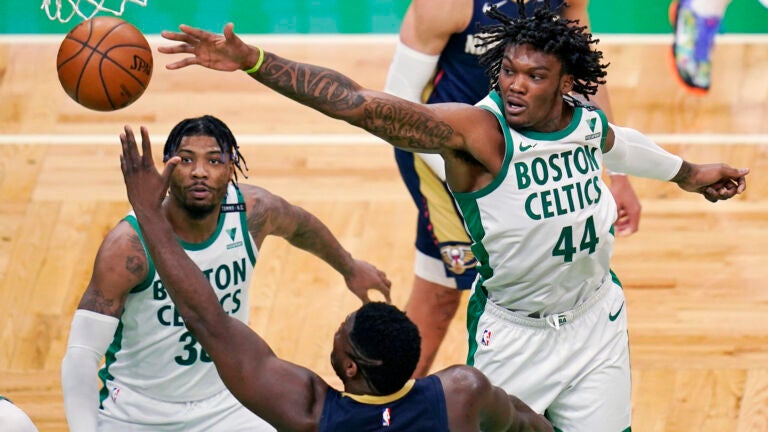In 2012, Smart's new deal would have stacked up with Dirk Nowitzki.

Over the last two weeks, the Celtics signed three players to extensions: Marcus Smart, Robert Williams, and Josh Richardson.
On a recent episode of the Ringer NBA Show, Kevin O’Connor and Chris Vernon discussed the Celtics’s recent deals. At one point, Vernon noted that it would be useful to have historical perspective on new contracts to show why big numbers that might sound daunting really aren’t in the modern era.
So here we are. We won’t do the entire NBA of course, but we can offer historical perspective for the Celtics’s three new deals from 10 and 20 years ago.
A couple of brief notes:
- We used this year’s salary cap instead of next year’s (when the extensions actually kick in) because we know what the actual number is this season: $112.4 million. These numbers will fluctuate a bit, but they aren’t likely to move too much. If anything, they could become more friendly in the future if the cap spikes.
- When estimating how much of a team’s cap space a contract would eat up, we used the player’s average salary, which isn’t technically accurate for Smart and Williams — since they are on multi-year deals, they are both projected to receive raises every year, and they actually start significantly lower than their average. Still, since we were fudging the salary cap number anyway, it felt more informative to use the average salary rather than the actual number for 2022-23. If we were trying to give a more accurate picture of the Celtics from a team-building perspective, rather than offering a historical perspective, we would use accurate numbers.
- Our “percent of the cap” numbers are all rounded.
Here we go.
Marcus Smart
Contract: Four years, $77 million ($19.1 million/year — 16 percent of the cap)
If Smart’s contract kicked in this year, he would be the 61st-highest paid player in the NBA.
Comparable contracts in 2012 (35 percent of the cap)
Pau Gasol — $18.7 million (6th-highest paid)
Dirk Nowitzki — $19.1 million (5th)
Rashard Lewis/Tim Duncan — $21.1 million (3rd/4th)
Comparable contracts in 2002 (45 percent of the cap)
Alonzo Mourning — $18.7 million (3rd)
Shaquille O’Neal — $21.4 million (2nd)
Robert Williams Contract: Four years, $54 million ($13.5 million/year — 12 percent of the cap)Per the Athletic’s Jay King, Williams is unlikely to reach his full total due to difficult incentives. However, for our purposes here, let’s assume he does.
If Williams’ contract kicked in this year, he would be the 94th-highest player in the league.
Comparable contracts in 2012 (25 percent of the cap)
Tyson Chandler — $13.1 million (31st-highest paid)
Carlos Boozer — $13.5 million (30th)
LaMarcus Aldridge — $14 million (29th)
Comparable contracts in 2002 (32 percent of the cap)
Gary Payton — $12.9 million (9th)
Dikembe Mutombo — $14.3 million (8th)
Josh Richardson
Contract: One year, $12.3 million (11 percent of the cap)
If Richardson’s contract kicked in this year, he would be the 109th-highest paid player in the NBA.
Comparable contracts in 2012 (23 percent of the cap)
Danny Granger — $12 million (39th-highest paid)
Luol Deng — $12.3 million (38th)
Josh Smith — $12.4 million (37th)
Comparable contracts in 2002 (29 percent of the cap)
Reggie Miller — $12 million (13th)
Damon Stoudamire — $12.4 million (12th)
Chris Webber — $12.8 million (11th)
Conclusions
The biggest takeaway here? If you have an issue with a contract, make sure you’re worried about the cap percentage — not the number. All three contracts would have been hefty in 2012 (and very hefty in 2002), but they look friendly to the Celtics’ cap sheet in 2021 when placed in proper perspective.
Get the latest Boston sports news
Receive updates on your favorite Boston teams, straight from our newsroom to your inbox.
"smart" - Google News
August 25, 2021 at 10:19AM
https://ift.tt/3kr9e7N
Here’s how Celtics extensions for Marcus Smart, Robert Williams, and Josh Richardson stack up historically - Boston.com
"smart" - Google News
https://ift.tt/2P2kUhG
https://ift.tt/3febf3M
Bagikan Berita Ini














0 Response to "Here’s how Celtics extensions for Marcus Smart, Robert Williams, and Josh Richardson stack up historically - Boston.com"
Post a Comment